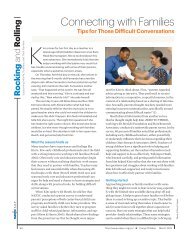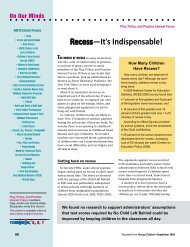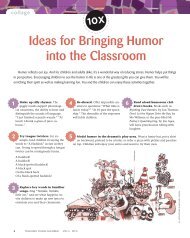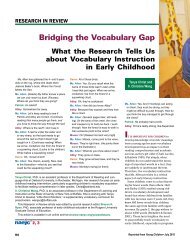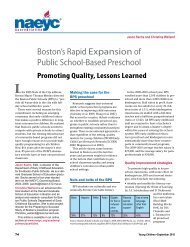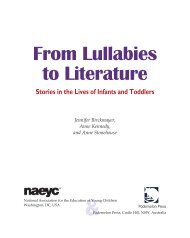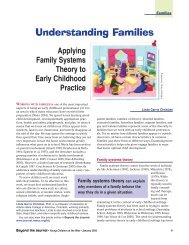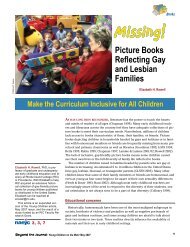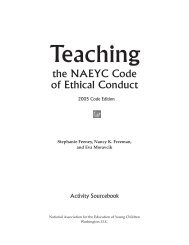The Power of Documentation - National Association for the ...
The Power of Documentation - National Association for the ...
The Power of Documentation - National Association for the ...
Create successful ePaper yourself
Turn your PDF publications into a flip-book with our unique Google optimized e-Paper software.
Conclusion<br />
Stage<br />
1. Deciding to document<br />
2. Exploring technology use<br />
3. Focusing on children’s<br />
engagement<br />
4. Ga<strong>the</strong>ring in<strong>for</strong>mation<br />
5. Connecting and telling<br />
stories<br />
6. Documenting decision<br />
making<br />
<strong>Documentation</strong> can be a rewarding<br />
process when educators understand<br />
<strong>the</strong> value associated with collecting<br />
evidence and producing a summary<br />
presentation, whe<strong>the</strong>r in a bulletin<br />
board, panel, video, or o<strong>the</strong>r <strong>for</strong>mat.<br />
To become a documenter, one must<br />
first understand what to observe<br />
and what to do with <strong>the</strong> in<strong>for</strong>mation<br />
collected. It takes time and practice<br />
to learn which experiences support<br />
Stages <strong>of</strong> Documenter Experience<br />
Experience<br />
Documenters ask, “What should I document?” <strong>The</strong>y<br />
collect artwork from every child but at first tend to<br />
create busy bulletin boards with too much in<strong>for</strong>mation.<br />
Concerned with equity, many include every item<br />
ra<strong>the</strong>r than being selective.<br />
Documenters explore how to use equipment and<br />
photographs from various events and experiences.<br />
Most <strong>of</strong> <strong>the</strong> photos are displayed on bulletin boards<br />
or inserted in photo albums. <strong>The</strong> video clips are<br />
placed in slideshows or movies and shown to children<br />
and parents.<br />
Documenters learn to photograph specific things<br />
and events with <strong>the</strong> intent <strong>of</strong> capturing a piece <strong>of</strong> <strong>the</strong><br />
story <strong>of</strong> children engaged in learning.<br />
Documenters title <strong>the</strong> photographs, events, and<br />
experiences and begin to write descriptions that tell<br />
<strong>the</strong> story <strong>of</strong> children’s learning.<br />
Documenters combine work samples, photographs,<br />
descriptions, and miscellaneous in<strong>for</strong>mation in support<br />
<strong>of</strong> <strong>the</strong> entire learning event. <strong>The</strong>y tell <strong>the</strong> whole<br />
story with a beginning, middle, and an end, using<br />
supporting artifacts.<br />
Documenters frame questions, reflect, assess, build<br />
<strong>the</strong>ories, and meet learning standards, all with <strong>the</strong><br />
support <strong>of</strong> documentation.<br />
effective documentation and how to<br />
collect artifacts and evidence.<br />
Next, as documenters learn why <strong>the</strong><br />
in<strong>for</strong>mation is important, <strong>the</strong>y begin<br />
to understand <strong>the</strong> value <strong>of</strong> documentation<br />
<strong>for</strong> different audiences and come<br />
92 Young Children • March 2008<br />
Value<br />
Documenters show pride in <strong>the</strong><br />
children’s work.<br />
Documenters work hard to<br />
learn more about technology.<br />
<strong>The</strong>y show pride in <strong>the</strong> children’s<br />
actions by displaying<br />
photos and video clips.<br />
Documenters become technologically<br />
competent and able<br />
to focus on important learning<br />
events and experiences.<br />
Documenters begin to connect<br />
children’s actions and<br />
experiences.<br />
Documenters continue to use<br />
documentation artifacts to connect<br />
children’s actions and<br />
experiences to curriculum and<br />
learning standards.<br />
Documenters become reflective<br />
practitioners who document<br />
meaningful actions/events,<br />
explain why <strong>the</strong>y are important,<br />
and push <strong>the</strong>mselves and o<strong>the</strong>rs<br />
to continue thinking about<br />
<strong>the</strong>se experiences.<br />
to recognize why certain aspects <strong>of</strong><br />
child development are important<br />
to assess. In addition, documenters<br />
learn that administrators and parents<br />
value this in<strong>for</strong>mation, yet it also has<br />
value to <strong>the</strong> children and <strong>the</strong> teacher<br />
Often <strong>the</strong> documentation provides insights into chil-<br />
dren’s thinking and helps drive <strong>the</strong> future curriculum.





